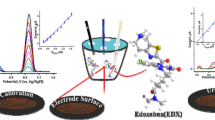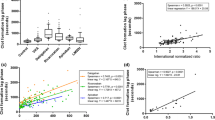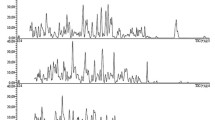Abstract
Complications in anticoagulation therapy and long term consequences of the post thrombotic syndromes requires a fast and powerful therapy such as heparin therapy (anticoagulation) to minimize the thrombotic effects in patients. Thus, a simple approach via electrochemical method: Differential pulse polarography (DPP) has been developed for heparin analysis as a powerful clinical tool to monitor anticoagulation action in-patient undergoing heparin therapy. The method has been standardized for determination of heparin activity over the existing methods and a very well defined characteristic reduction peak at −1.25 V in 2 M NaOH was observed for heparin. A linear relation was observed with a regression equation as y = 0.3117x + 0.8069, for 0.1 to 2.0 units/ml heparin. The developed DPP method was observed with excellent precision, accuracy and recovery in human blood plasma samples and in pharmacological formulations. The limit of detection (LOD) and limit of quantification (LOQ) noticed to be 2.04 and 6.8 units/ml respectively. The DPP results compared with pharmacological screening through average thrombin time (TT) and applied to monitor invitro anticoagulation action of heparin in healthy human subjects. Statistical analysis done to validate developed DPP method for heparin analysis and its probable clinical use to monitor anticoagulation action to treat patients suffering from various cerebrovascular disorders (CVD) by proper dosing of heparin.



Similar content being viewed by others
References
European Stroke Council, European Neurological Society and European Education of Neurological Societies (2000) European stroke recommendations for stroke management. Cerebrovasc Dis 10: 335–351
Collins R, Macmohan S, Flather M et al (1996) Clinical effects of anticoagulation therapy in suspected acute myocardial infarction: systematic overview of randomized trials. Br Med J 313:652–659
Francis CW, Kaplan KL (2006) Principles of antithrombotic therapy, chapter 21. In: Lichtman MA, Beutler E, Kipps TJ et al (eds) Williams hematology, 7th edn. McGraw-Hill, New York
Hirsh J, Anand SS, Halperin JL, Fuster V (2002) Guide to anticoagulant therapy: heparin: a statement for healthcare professionals from the American heart association. Circulation 103(24):2994–3018
Charles O, Anna G (2007) Los Angeles times report: Dennis Quaid’s twins get accidental overdose, 21 Nov 2007
Dennis Quaid Files Suit over Drug Mishap (2007) Los Angeles Times, 5 Dec 2007
At a Glance Heparin Overdose at Hospital (2008) Dallas Morning News, 11 July 2008
Officials Investigate Infants’ Heparin OD (2008) ABC News, Texas Hospital, 11 July 2008
Heparin Overdose Kills Toddler at Hospital (2010) Staff Investigated, KETV Omaha, 31 Mar 2010
Vogel P (2009) Quantitative chemical analysis, 6th edn. Dorling Kindersley (India) Pvt. Ltd., Pearson, pp 511–514
Salvatore SS, Slawko Y, Leon Y (1972) Kinetics of the acid hydrolysis of heparin from its Cu (II) complex and its relation to biological activity. Interscience Publishers Inc, New York
Sun W, Jio K, Han J, Lu L (2000) Linear sweep voltammetric determination of heparin based on its interaction with neutral red. Chin J Chem 12:451–455
Brezina M, Zuman P (1958) Polarography in medicine, biochemistry and pharmacy. Interscience Publishers Inc, New York
Simmons A (1980) Technical hematology, 3rd edn. J. D. Lippincott, Philadelphia, pp 365–371
Louis M, Kolthoff IM (1965) Polarographic techniques, 2nd edn. Interscience Publishers, Newyork, p 628
Turpie AG, Robinson JG, Doyle DJ (1989) Comparison of high dose with low dose subcutaneous heparin to prevent left ventricular mural thrombosis in patients with acute transmural anterior myocardial infarction. N Engl J Med 320:352–357
Flanders MM, Crist R, Rodgers GM (2003) Comparison of five thrombin time reagents. Clin Chem 49(1):169–172
Gastineau DA, Gertz MA, Daniels TM, Kyle RA, Bowie EJ (1991) Inhibitor of the thrombin time in systemic amyloidosis: a common coagulation abnormality. Blood 77(12):2637–2640
Cruickshank MK, Levine MN, Hirsh J et al (1996) A standard heparin nomograms for the management of heparin therapy. Arch Intern Med 151:333–337
Riley CM, Rosanke TW (1996) Development and validation of analytical methods. Elsevier Science Ltd., New York
Swatz ME, ISl Krul (1997) Analytical method development and validation. Marcel Dekker, New York
Frydman AM, Bara L, LeRoux Y et al (1988) The antithrombotic activity and pharmacokinetic of enoxaparin, a low molecular weight heparin in humans given single subcutaneous doses of 20 up to 80 mg. J Clin Pharmacol 28:609–618
Rosenberg RD, Lam L (1979) Correlation between structure and function of heparin. Proc Natl Acad Sci USA 76:1218–1222
Coombe DR, Kett WC (2006) Heparan sulfate-protein interactions: therapeutic potential through structure–function insights. Cell Mol Life Sci 62(4):410–424
Author information
Authors and Affiliations
Corresponding author
Rights and permissions
About this article
Cite this article
Singh, N. Electrochemical Assay of Heparin to Monitor Anticoagulation Action in Cardiovascular Patients. Indian J Hematol Blood Transfus 28, 97–104 (2012). https://doi.org/10.1007/s12288-011-0111-1
Received:
Accepted:
Published:
Issue Date:
DOI: https://doi.org/10.1007/s12288-011-0111-1




